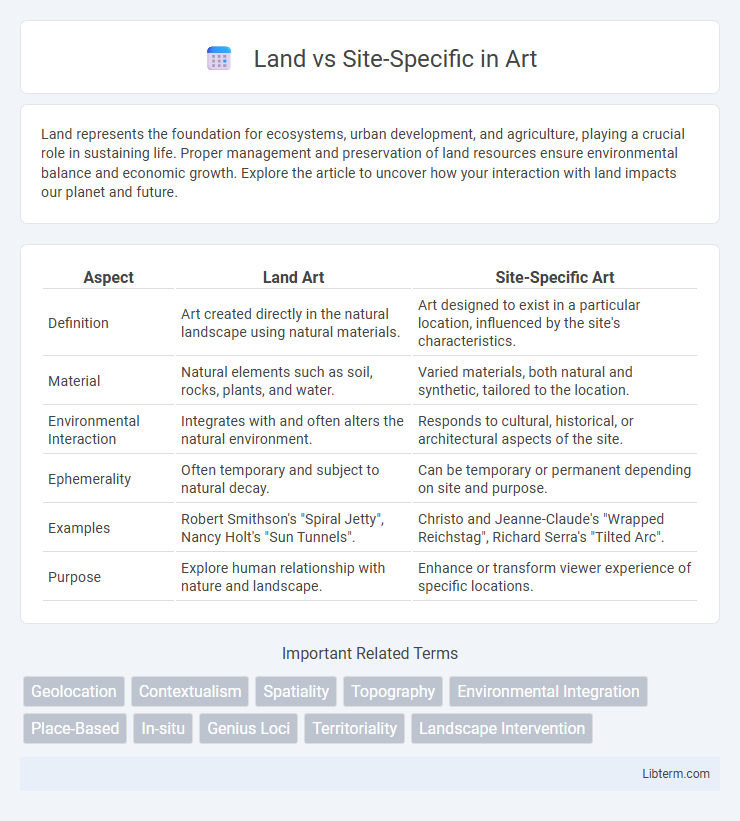Land represents the foundation for ecosystems, urban development, and agriculture, playing a crucial role in sustaining life. Proper management and preservation of land resources ensure environmental balance and economic growth. Explore the article to uncover how your interaction with land impacts our planet and future.
Table of Comparison
| Aspect | Land Art | Site-Specific Art |
|---|---|---|
| Definition | Art created directly in the natural landscape using natural materials. | Art designed to exist in a particular location, influenced by the site's characteristics. |
| Material | Natural elements such as soil, rocks, plants, and water. | Varied materials, both natural and synthetic, tailored to the location. |
| Environmental Interaction | Integrates with and often alters the natural environment. | Responds to cultural, historical, or architectural aspects of the site. |
| Ephemerality | Often temporary and subject to natural decay. | Can be temporary or permanent depending on site and purpose. |
| Examples | Robert Smithson's "Spiral Jetty", Nancy Holt's "Sun Tunnels". | Christo and Jeanne-Claude's "Wrapped Reichstag", Richard Serra's "Tilted Arc". |
| Purpose | Explore human relationship with nature and landscape. | Enhance or transform viewer experience of specific locations. |
Understanding Land and Site-Specific: Key Definitions
Land refers to a broad geographic area encompassing various types of natural and developed environments, including soil, water, minerals, and vegetation. Site-specific pertains to a precise location within that land, characterized by unique physical, environmental, or cultural features that influence its use and management. Understanding the distinction between land as a general resource and site-specific conditions is essential for effective planning, environmental assessment, and sustainable development strategies.
Historical Perspectives on Land Art and Site-Specific Installations
Land art emerged in the late 1960s as artists like Robert Smithson and Michael Heizer transformed natural landscapes into large-scale sculptural interventions, emphasizing the earth as both medium and subject. Site-specific installations evolved concurrently, focusing on the interaction between artwork and its unique environment, often in urban or architectural contexts, as seen in works by Richard Serra and Christo and Jeanne-Claude. Historical perspectives highlight how land art challenged traditional gallery spaces, shifting artistic practice toward environmental engagement and cultural commentary embedded within specific geographic locations.
Core Differences Between Land Art and Site-Specific Art
Land Art transforms natural landscapes into immersive artistic expressions by integrating large-scale earthworks, often in remote locations, emphasizing the interaction between art, nature, and geography. Site-Specific Art, however, is created with the particular characteristics, context, and history of a precise location in mind, focusing on how the artwork responds to and alters the viewer's experience of that site. The core difference lies in Land Art's emphasis on reshaping the environment itself, whereas Site-Specific Art prioritizes dialogue with the existing spatial, cultural, or architectural features of a designated place.
Environmental Impact: Land vs Site-Specific Approaches
Land-specific approaches assess environmental impact broadly across a larger geographic area, evaluating cumulative effects on ecosystems, biodiversity, and natural resources. Site-specific approaches focus on localized environmental assessments, targeting precise impacts on soil quality, water resources, and habitat disruption at the project location. Detailed site-specific analysis enables more accurate mitigation strategies, minimizing negative effects on flora, fauna, and surrounding communities.
Artistic Intent: Purpose and Audience Engagement
Artistic intent in land art emphasizes creating works that harmonize with natural landscapes, fostering a deep connection between the environment and audience through immersive experiences. Site-specific art, tailored to a particular location, aims to convey meaning that resonates with the cultural or historical context, enhancing audience engagement by reflecting unique site characteristics. Both forms prioritize purpose-driven creation, but land art often invokes broader ecological themes while site-specific art targets localized narratives and community interaction.
Materials and Techniques Utilized in Both Practices
Land art employs natural materials such as rocks, soil, and vegetation, utilizing techniques like earthmoving and sculpting to create large-scale outdoor installations that interact directly with the environment. Site-specific art integrates a broader range of materials including industrial products, mixed media, and architectural elements, with techniques tailored to the unique characteristics and cultural context of the location. Both practices emphasize material selection and methods that respond to and enhance their specific surroundings, yet land art remains rooted in organic manipulation while site-specific art often incorporates constructed or fabricated components.
Notable Artists and Influential Works
Notable artists in land art such as Robert Smithson, with his seminal work "Spiral Jetty," revolutionized the relationship between art and environment by using natural landscapes as their canvas. Site-specific art, exemplified by Christo and Jeanne-Claude's installations like "The Gates" in Central Park, emphasizes the integration of artwork within a particular location's cultural or architectural context. These influential works highlight the evolving dialogue between nature, space, and artistic expression, shaping contemporary visual art narratives.
Preservation, Documentation, and Longevity Issues
Land preservation prioritizes conserving natural ecosystems and cultural landscapes, emphasizing minimal disturbance and long-term environmental sustainability. Site-specific preservation targets individual locations with historical or cultural significance, requiring detailed documentation and tailored conservation strategies to maintain authenticity and structural integrity. Longevity challenges differ as land preservation focuses on ecological resilience, while site-specific efforts address material degradation and precise restoration methods to ensure enduring heritage protection.
The Role of Context: Cultural and Ecological Significance
Land art emphasizes the broader landscape's natural elements, integrating ecological features such as topography, climate, and native flora to reflect environmental significance. Site-specific art responds directly to cultural context, embedding historical narratives, local traditions, and community identity into the artwork's meaning. The role of context in both approaches highlights how cultural heritage and ecological conditions shape artistic expression and viewer interpretation.
Future Trends in Land and Site-Specific Art
Future trends in land and site-specific art emphasize sustainable practices and immersive technologies, transforming natural landscapes into interactive experiences. Artists increasingly integrate augmented reality and environmental data to create dynamic, evolving installations that respond to ecological changes. Collaborative projects involving local communities and conservation efforts highlight the growing importance of cultural and ecological context in site-specific artworks.
Land Infographic

 libterm.com
libterm.com